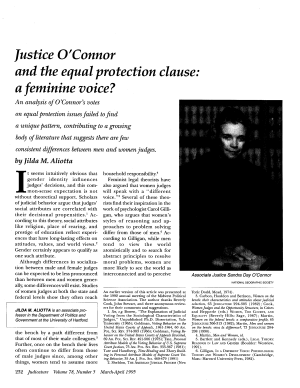Justice O'Connor and the Equal Protection Clause: A Feminine Voice?
January 1, 1995

DISCLAIMER: This text has been transcribed automatically and may contain substantial inaccuracies due to the limitations of automatic transcription technology. This transcript is intended only to make the content of this document more easily discoverable and searchable. If you would like to quote the exact text of this document in any piece of work or research, please view the original using the link above and gather your quote directly from the source. The Sandra Day O'Connor Institute does not warrant, represent, or guarantee in any way that the text below is accurate.
Article Text
(Excerpt, Automatically generated)
Justice O'Connor
and the equal protection clause: a feminine voice?
An analysis of O'Connor's votes
on equal protection issues failed to find
a unique pattern, contributing to a growing body of literature that suggests there are few
consistent differences between men and women judges.
I
by Jilda M. Aliotta
t seems intuitively obvious that gender identity influences judges' decisions, and this com mon-sense expectation is not
without theoretical support. Scholars of judicial behavior argue that judges' social attributes are correlated with their decisional propensities. 1 Ac cording to this theory, social attributes like religion, place of rearing, and prestige of education reflect experi ences that have long-lasting effects on attitudes, values, and world views. 2 Gender certainly appears to qualify as one such attribute.
Although differences in socializa tion between male and female judges can be expected to be less pronounced than between men and women gener
household responsibility.4 Feminist legal theorists have
also argued that women judges will speak with a "different voice." 5 Several of these theo rists find their inspiration in the work of psychologist Carol Gilli gan, who argues that women's styles of reasoning and ap proaches to problem solving differ from those of men. 6 Ac cording to Gilligan, while men tend to view the world atomistically and to search for abstract principles to resolve moral problems, women are more likely to see the world as
interconnected
